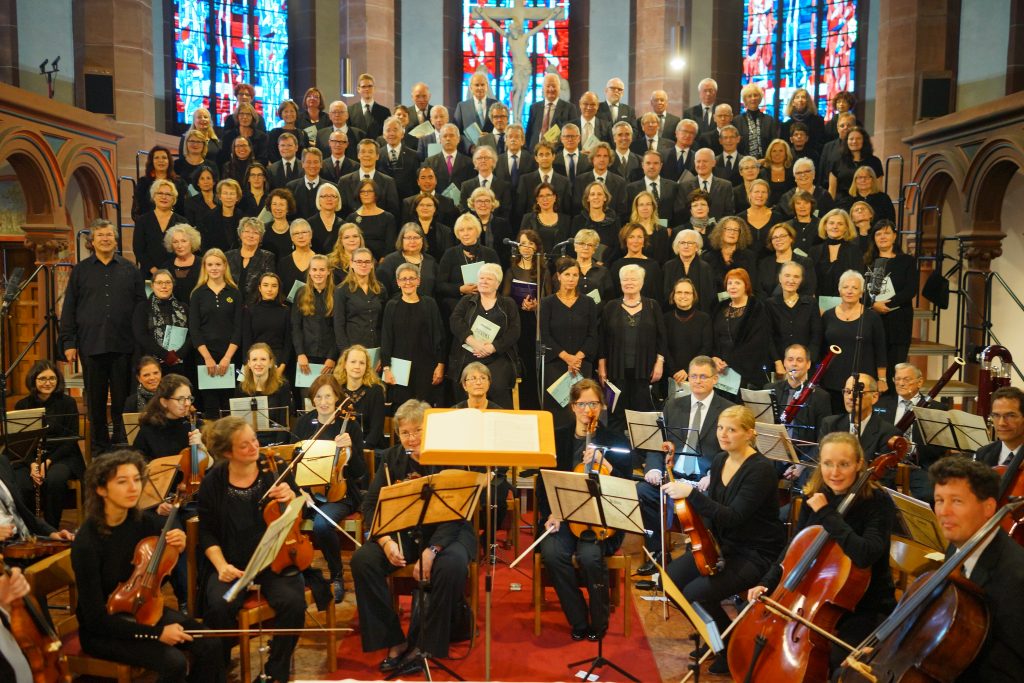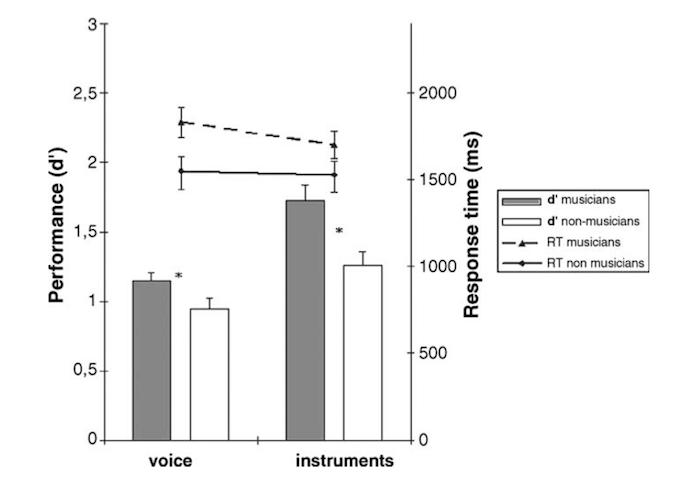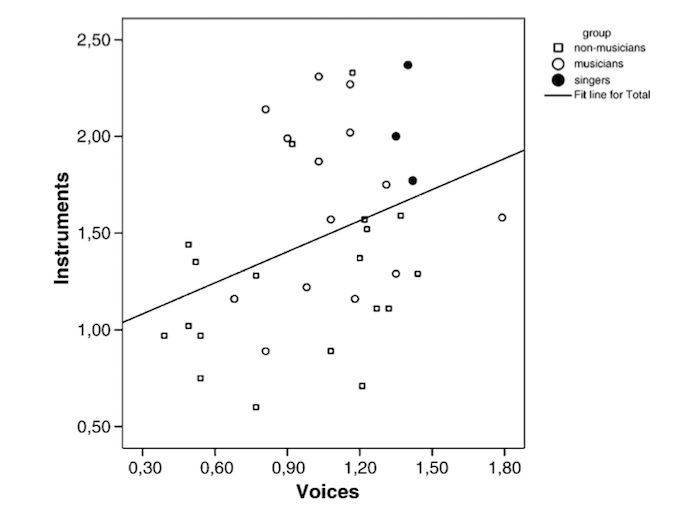
Title of paper under discussion
Superior voice timbre processing in musicians
Authors
Jean-Pierre Chartrand and Pascal Belin
Journal
Neuroscience Letters 405 (2006) 164–167
Link to paper (free access)
Overview
This study set out to compare musicians and non-musicians in their abilities to tell different timbres apart. In the first set of tasks, ‘instrumental timbre discrimination’, participants listened to 192 pairs of melodies played on instruments, and after each pair had to declare whether the second melody was played on the same or a different instrument compared with the first. In the second set of tasks, ‘vocal timbre discrimination’, participants again listened to 192 pairs of spoken syllables and after each pair had to declare whether the second syllable was spoken by the same or a different voice compared with the first. The speed, as well as accuracy, of responses were measured throughout.
Musicians, it turned out, were better than non-musicians at discriminating between different instrumental timbres and between different vocal timbres. But they took longer than non-musicians to do so, suggesting that musicians might employ more complex processing strategies, as well as making use of a larger short-term auditory memory.

Background
Defined by The American National Standards Institute as “that attribute of auditory sensation in terms of which a listener can judge that two sounds, similarly presented and having the same loudness and pitch, are different”, timbre is of course an element of vocal as well as instrumental sound. Though predicting that musicians would perform better than non-musicians at timbre discrimination in both the instrumental and the vocal tasks, our researchers admitted before the study that when it comes to vocal discrimination “it is possible that musicians do not perform better than non-musicians since voice processing is a common and frequent task in both groups.”

Method
36 participants, mostly undergraduate students from the University of Montreal, volunteered for the study, 17 musicians (including 3 singers) and 19 non-musicians of comparable ages.
For the ‘instrumental timbre discrimination’ tasks sixteen types of instrumental samples – 4 types of piano, 4 different string instruments, 4 types of guitar and 4 different brass instruments – were used. Each ‘instrument’ recorded two tracks, each track being a three-note sequence: ‘Track 1’ was always the notes C-E-G and ‘Track 2’ the notes C-D-G. The researchers created many combinations of Track 1 with Track 2; for example ‘Grand Piano, Track 1’ followed by ‘Trumpet, Track 2’, or ‘Violin, Track 1’ followed by ‘Violin Track 2’. Participants listened to a series of 192 of these melody pairs, and declared after each one, as soon as possible, whether they thought the instrument playing Track 1 was the same as, or different from, the instrument playing Track 2. (In reality, half of the pairs came from the same instrument, and half from different instruments)
For the ‘vocal timbre discrimination’ tasks sixteen people’s voices (American archive recordings) were used: 4 women, 4 men, 4 girls and 4 boys. Each voice had recorded two syllables: Track 1 was always “had” and Track 2 “heed”. Once more the researchers created many combinations of Track 1 and Track 2; so, for example, ‘woman 3 saying “had” followed by ‘girl 2 saying “heed”’, or ‘man 4 saying “had” followed by ‘man 4 saying “heed”’. As in the instrumental timbre experiment, participants listened to a series of 192 of these syllable pairs, and declared after each one, as soon as possible, whether they thought the voice saying Track 1 was the same as, or different from, the voice on Track 2. (And as above, half of the pairs came from the same voice, and half from different voices).
At the end of the experiment each participant was marked according to 1) the accuracy and 2) the speed of their responses.
Results
Although the vocal discrimination task was (according to the ‘accuracy’ scores) trickier than the instrumental discrimination task for both groups, musicians out-performed non-musicians at both. However, musicians were generally slower to give their responses than non-musicians. In this diagram, accuracy (or ‘performance’) is denoted by the bar columns (musicians in grey, non-musicians in white) and response time by the line trace (musicians dotted line, non-musicians solid line):

The researchers also found that in general, the better someone’s ability to discriminate voices, the better their ability to discriminate instruments too. Remarkably, the three singers taking part in the experiment (solid black circles in this graph) were each excellent at both:

Discussion
That musicians were better at distinguishing different instrumental timbres from one another came as no surprise to Chartrand and Belin – “considering the training that musicians have received with musical instruments, they were much more familiar than the non-musicians with the task involving instrument timbres”.
However, musicians out-performing non-musicians at voice discrimination was not such a predictable outcome; it could be said, they write, that “(m)usicians and non-musicians would have been expected to perform at the same level with the voice timbre discrimination task, since voice processing is a common domain of expertise across the whole population”. According to the authors “(o)ne interpretation of the results is that expertise with musical instrument timbres generalizes to other timbre tasks, such as voice discrimination.” They are especially keen to recommend future exploration of the finding that singing musicians were among the best performers in both discrimination tasks, wondering if there is a ‘“specific link between singing and timbre processing”.
Regarding the longer response times among musicians, Chartrand and Belin turn to previous research showing musicians to have “a larger short-term auditory memory” and being able to “process sound at a deeper level when they were given more time to encode the stimuli [sounds]”. So in this experiment, suggest the authors, “(a)lthough the participants were all instructed to respond as fast as possible while maintaining the lowest error-rate possible, the musicians took more time to respond overall and may have processed the sounds at a deeper level than the non-musicians, or used different cognitive strategies.”
The authors end the paper on a cautionary note: “The main goal of the present study was to assess if musical timbre expertise can be generalized to timbres of other auditory domains, like voices. Our results suggest that it can, but this statement is not without limitations. First of all, it is not known yet if musicians are better than non-musicians at other voice processing tasks, like voice recognition for example. Second, it is also not known yet if musicians would perform better with other kinds of auditory stimuli, like environmental sounds. Future studies need to focus on multiple types of sound categories and other types of sound processing to further evaluate differences between muscians and non-musicians”.

Coda
The Young Person’s Guide to the Orchestra by Benjamin Britten
Royal Philharmonic Orchestra, cold by André Previn